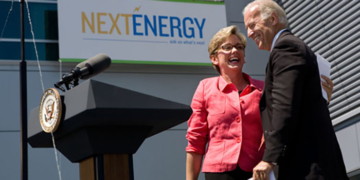Democrats are falling short on their goal to add nearly 1 million manufacturing jobs through the Inflation Reduction Act (IRA) over the next decade.
Senate Democrats boasted following the signing of the IRA that the legislation would create over 936,000 “clean” manufacturing jobs over the next decade, relying on a projection from the BlueGreen Alliance, a group that advocates for green union jobs, according to a fact sheet released in September 2022. Since September 2022, the U.S. economy has only added 62,000 jobs in the manufacturing sector and only 20,000 over the last year ending in April, according to the Federal Reserve of St. Louis (FRED).
To be on track with the Senate Democrats’ estimate, manufacturing would have to add 7,800 jobs a month, which would equate to 156,000 as of April. The report from BlueGreen Alliance estimates that 561,000 jobs would be created over the next decade due to just tax credits for solar, wind and battery production and 115,000 in clean manufacturing investment.
“The IRA has done absolutely nothing to facilitate manufacturing job growth,” E.J. Antoni, a research fellow at the Heritage Foundation’s Grover M. Hermann Center for the Federal Budget, told the Daily Caller News Foundation. “After April 2020, the sector experienced fast job growth, as did almost all sectors of the economy, because people were simply returning to work as lockdowns were lifted. Until October 2022, the economy was adding over 50,000 manufacturing jobs per month on average. After October 2022, however, the growth essentially evaporated and employment in manufacturing has been flat since then, rising an anemic 0.2% over a year and a half — that’s less than 0.1% annually! The change in these government numbers is so small that it’s not statistically significant, meaning we can’t be sure the change between October 2022 and April 2024 was even positive.”
Senate Democrats also argued, using data commissioned by the BlueGreen Alliance and analyzed by the Political Economy Research Institute at the University of Massachusetts Amherst, that the total investment in the IRA will create over 9 million total jobs in all sectors over the next decade. The IRA authorized $750 billion in new spending, including $370 billion to combat climate change.
The White House boasted in August 2023, a year after the signing of the IRA, that the legislation had created more than 170,000 “clean energy jobs” and had resulted in investments of over $110 billion in clean energy manufacturing. The Biden administration cites growth in the electric vehicle, semiconductor and clean energy industries.
Semiconductor and other electronic component manufacturing increased by just 400 jobs in April from the month before, but was down by 3,400 in the last year, according to the Bureau of Labor Statistics. Employment in manufacturing for motor vehicles and parts fell by 2,100 in April from March but was up by 29,900 over the last year.
Our Administration is launching four new Workforce Hubs to connect workers with good-paying jobs in growing industries – in MI, PA, WI, and NY.
These new hubs will support semiconductor manufacturing, lead pipe replacement, electric vehicle manufacturing, and more. pic.twitter.com/OAhAptvjHl
— The White House (@WhiteHouse) April 27, 2024
Manufacturing jobs have largely stagnated since rebounding from losses during the COVID-19 pandemic, oscillating between 12,966,000 and 12,923,000, according to FRED. The number of manufacturing jobs declined rapidly in April 2020 to 11,419,000 from 12,780,000 in February of that year due to COVID-19 pandemic shutdowns.
“So, shortly after Biden signed the IRA, the manufacturing sector hit a brick wall and hasn’t budged since then,” Antoni told the DCNF. “The Biden administration is unlikely to get their goal of 1 million ‘green’ manufacturing jobs, but even if they did, those jobs would be much like the jobs created by the New Deal: paying one man to dig a ditch and another to fill it in. There’s no increase in production, no increase in wealth, no expansion of the economy. ‘Green’ manufacturing is not about building America; it’s about building campaign donations for the far left.”
The manufacturing sector as a whole has contracted in all but one of the last 18 months, measuring at 49.2% in April, with a value below 50% representing shrinkage, according to a report from the Institute for Supply Management. The only time in the last 18 months that the manufacturing sector did not contract was in March when the index measured 50.3%.
The Treasury Department claimed in October 2023 that just the climate and clean energy tax incentives would support more than 1 million jobs in energy and related manufacturing sectors over the next decade, according to a fact sheet from the department. The tax incentives announced by the Treasury require that workers be paid a “local prevailing wage” and that a certain portion be in a registered apprenticeship program, incentivizing union labor.
The U.S. labor market has grown in other ways since the passage of the IRA, adding 2.8 million jobs in the past year, but over 20% of those were in the government. Job growth in April amounted to 175,000, far lower than the economists expectations of 242,000.
The White House deferred the DCNF to previous statements.
All content created by the Daily Caller News Foundation, an independent and nonpartisan newswire service, is available without charge to any legitimate news publisher that can provide a large audience. All republished articles must include our logo, our reporter’s byline and their DCNF affiliation. For any questions about our guidelines or partnering with us, please contact [email protected].



























 Continue with Google
Continue with Google